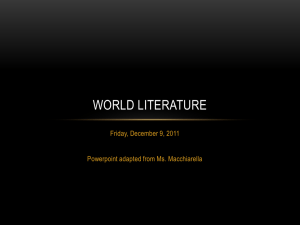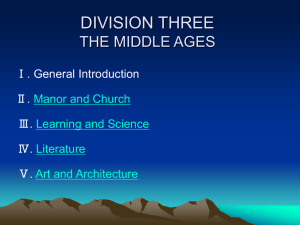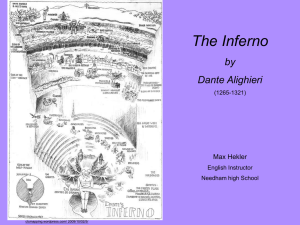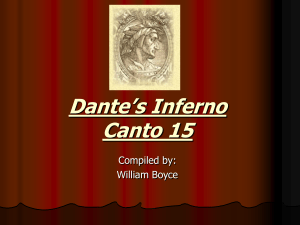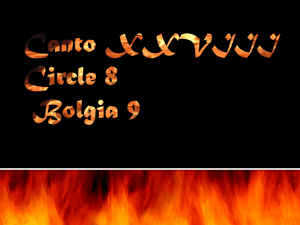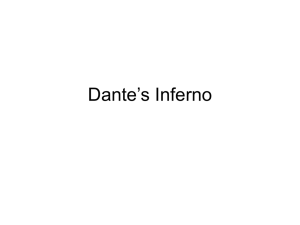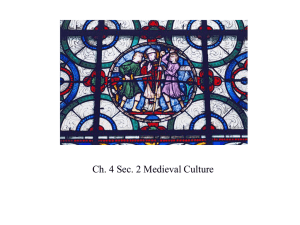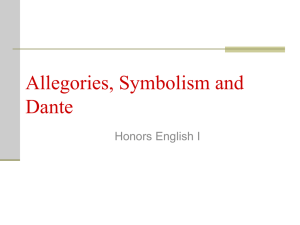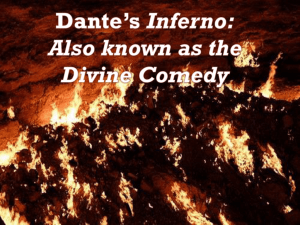Divine Comedy Inferno - Mrs-Wilmarths-Wiki
advertisement
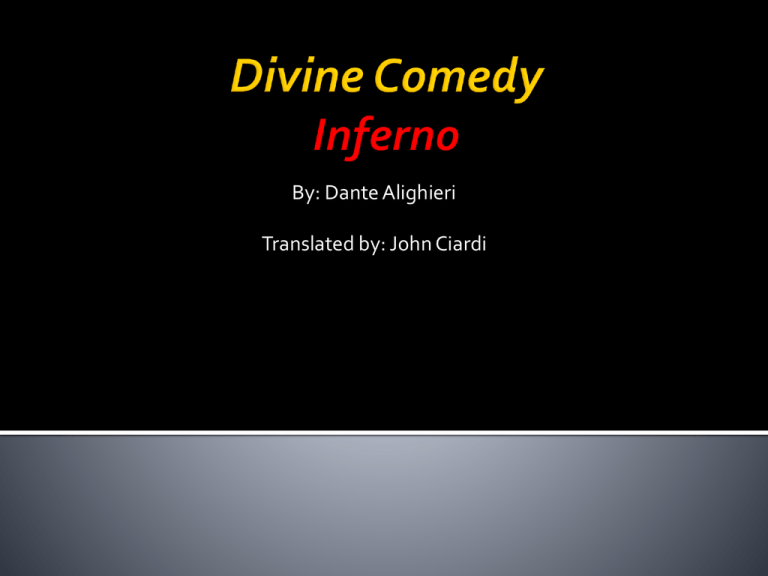
By: Dante Alighieri Translated by: John Ciardi 1. Who is one of the greatest poets in Western civilization? Dante Alighieri 2. Who is he compared to? William Shakespeare 3. What has he written about? Hell 4. Where is Dante Alighieri from? Florence, Italy 5. What was his economic status growing up? Poor but noble 6. What problems were happening in his country at the time? Since Italy was not unified, the city states were marked with political turbulence and power struggles between ruling families. So the cities were constantly at war with each other while civil wars went on as well 7. What was Alighieri’s job? He was an elected official. 8. What happened in 1300? A civil war broke out & all of Alighieri’s political party was overthrown 9. What happened to Dante in 1302? He was exiled from Florence & this experience played a role in his writing 10. Where and what did Dante study? University of Bologna; law and rhetoric 11. What language were most people writing in? What language did Dante want to write in? Latin; Italian 12.What was Dente’s greatest piece of literature? Divine Comedy 13. What did this story document? The physical and spiritual journey of a man named Dante 14. What number reappeared in this story? Why? Three; it represented the trinity 15. What are the three parts of The Divine Comedy? Inferno, purgatorio, and paradiso 16. How many cantos are in each? 33 17. Which section takes place on Earth & has an intro canto? Inferno 18. What is terzo rima? A stanza of three lines 19. How long is Dante’s journey and when does it take place? Three days; between Good Friday and Easter Sunday 20. Who helps Dante on his pilgrimage? His love, Beatrice 21. Who was Dante’s muse? What was her role? Bea-trice Portinari; led him out of despair 22. How did she inspire him? She was the subject of Dante’s love poetry, the object of his religious quest, and a symbol of spiritual purity. 23. What does she literally and symbolically connect? She links Heaven and Earth 24. When/where did Dante die? 1321 in Ravenna (in N. Italy) 25. What is an allegory? A literary work with two levels of meaning – literal and symbolical 26. What details of the story can be represented literally as well as symbolically? Every detail including characters and the plot (see examples in book) 27. What does the literary journey symbolize? A man’s struggle for redemption 28. What is imagery? The use of language that appeals to one or more of the five senses and creates a mental picture for the reader 29. Why does the author use imagery? To make the allegorical world seem tangible and real and helps the reader feel the ideas the author is presenting. * Now copy the eight vocabulary words into your notebook. The Divine Comedy is broken into three sections. We will be reading four excerpts from “Inferno” (Hell). Dante’s Hell is set up in a series of downward spirals, the sins of the people worsen the farther down the spiral Dante goes. Lucifer is in the lowest and smallest circle. Canto I 1. What season is it? Easter, around March 21st 2. What part of his life is Dante in? Mid-point of his life (35 yrs old) 3. Where does he find himself at this point in his life? He strayed from “the True Way,” into a Dark wood of error. 4. What do you think this means? He is not on the right path (morally) 5. What words or phrases lead up to believe this story is an allegory? Life is a journey; veering from the correct path; being alone in the dark woods 6. How as Dante feeling about the woods? He was fearful 7. How is this story being told? As a flashback 8. How did Dante get into this predicament? He is not sure because of a lack of sleep 9. When he realizes what has happened, what does he do? He looks up and sees the sun, which represents God 10. What did Dante compare himself to? Lines 22-24 A swimmer struggling to move towards shore (simile) 11. What does he set out to do? Climb the Mount of Joy 12. Who/what stops him? How did it do this? A spotted Leopard; Blocked Dante’s path 13. What did Dante consider doing? Going back into the woods 14. What time of day did this occur? What was symbolized? At the first sign of dawn; Creation/Rebirth 15. What did Dante meet next & How did Dante react? A Lion ;He shook with dread 16. What was the last beast Dante met? A She-wolf 17. What has she done? Tortured any souls; allegorically, she is the temptation of sin 18. How did Dante react to her? He lost hope of climbing the mountain 10. What were the beasts thought to represent? The three divisions of Hell (fraud, violence, and incontinence: lack of self-restraint) 20. Which beast does Dante seem to fear the most? The she-wolf 21. What do these things do to Dante? Drive him back into the Dark Wood in despair 22. Who appeared just has Dante appeared lost? Describe him. A non-Christian poet who is no longer living Virgil (symbol of human reason) 24. How does Dante react to Virgil? He seems impressed and refers to Virgil as his true master and first author, and then Dante explains that he is trying to avoid the beasts. Dante asks for Virgil’s protection 25. What does Virgil suggest? They have to take another route 26. What does Virgil offer to Dante? To be his guide around the beasts 27. What does the journey entail? A trip through Hell (second death/damnation,) Going through purgatory (a burning mountain) 28. Who will guide Dante after this point? Beatrice (the symbol of divine love) 29. From there where would Dante go? The mountain (Heaven) 30. Why can’t Virgil take him on the last part of the journey? He is not Christian, so he only represents Human reasoning, not the divine 31. Does Dante take Virgil up on his offer to guide him? What do they do? Yes & they begin their journey through Hell After Reading Canto I 1.Based on his thoughts, actions, and emotions, describe Dante. Dante is educated; he values learning and literature; he is emotional. 2.What idea does each beast represent? Why is each appropriate. The leopard’s look can vary and fool viewers, depending on how many spots it has. It represents deceit. People often think of the lion as the proud king of the animals, but he is also a cruel hunter. It represents pride and cruelty. The She-wolf, which represents greed, is viewed as ravenous. 3. Since an allegory has a literal and symbolic mean, explain the allegory we see in Canto I. Literally, Dante wakes up in a forest. He sees the sun rising over a hill and wants to go there, but three beasts block his way. To get around the beasts, he must go on a longer, harder journey through Hell & Purgatory. Symbolically, Dante has gotten off the morally right path. He sees Heaven & the light of God, but cannot go there because of his sins. Although it may be hard, Dante has to recognize & renounce his sins before he could get to Mount Joy. 1. Where does the gate lead to? The City of Woe, where the forsaken souls with eternal sorrow are 2. How long has the gate existed, how long will it remain in existence? It existed from the beginning (older than love and intellect) and it will remain there forever 3. What is the last message the gate gives those who enter? Abandon all hope 4. Where did lines 1-12 appear? In the stone above the gate. 5. When Dante asks what the inscription means, what is he told? Here Dante must gather his soul against cowardice because he will encounter the fallen people who have lost the good of intellect 6. Now that Virgil and Dante are beginning their journey, why do you think it is important that Dante’s guide is Virgil? Virgil is someone who Dante respects and admires. Because of this, Virgil is able to get Dante’s trust to lead him through his fears. 7. What is some evidence to help prove this? Virgil convinces Charon to let him pass. Dante takes not only Virgil’s advice, but his hand as they entered through the gates of Hell. Virgil tried to explain some of the things that Dante could expect and tried to prepare him how to act. 8. As they crossed, what did they encounter? Sighs, cries, wails all echoing a confusion of languages and accents with tones of pain and anger. Shrill voices. Whirls of dirty air 9. What tone does this set? One of chaos, disorder and confusion 10. How does Dante react? He said they split his soul to tears, and in horror, asks Virgil who the voices belong to 11. What does Virgil explain? This is where the nearly soulless who neither took the side of good nor bad are. 12. Why do they cry out? Because they have no hope for death & they envy every other fate. 13. What does Virgil suggest about these souls? Don’t talk to them and keep moving. 14. Did Dante know anyone in this section of Hell? Yes, he recognized several souls including Pope Celestine V, who allowed himself to be convinced that no man can live without being damned, and because of this, hid away and the pope who corrupted the church came to power. 15. Does Dante immediately find out why people want to cross the river? What is he told? No, but he will find out when they are standing on the banks of Acheron. 16. Who do they see & what is he saying? An old man (Charon). He tells them to abandon hopes of paradise. 17.What is on the other shore? Eternal darkness 18. What does he recognize about Dante? That he does not belong in Hell because he isn’t dead. 19. How does Dante convince Charon to let them pass? He tells Charon that this journey was to be fulfilled to appease God . 20. How do the spirits react to Charon’s voice? Their teeth chatter and they turn pale because of their fear. 21. What did the spirits do? Spoke badly about God, their parents, their time on Earth, and Adam and Eve; they cried and cursed. 22. Why go to the shore? What happens on there? That is where all go who lose the fear of God. They will weep and curse. 23. What are the sinners compared to? Falling leaves in autumn (simile) 24. What allusion is made in lines 111-114? To the fall of Adam and Eve (the fall of man) 25. Why would Charon become enraged at Dante’s presence? Because no soul in Grace (destined for Heaven) crosses the River into Hell. 26. What happened to Dante at the end of this canto? He was overcome with terror and fainted. After Reading 1. Who/what do you think Dante the character represents in this allegory? He represents a good Christian who realizes that he has strayed from the “True Way,” or moral life. 2. Why can’t Virgil accompany Dante to Heaven? Why do you think Dante the author Chose to use Virgil instead of a Christian figure or philosopher? Virgil is not a Christian since he lived before Christians existed and worshiped many gods. Dante probably chose Virgil because he admired his writing and creativity.
